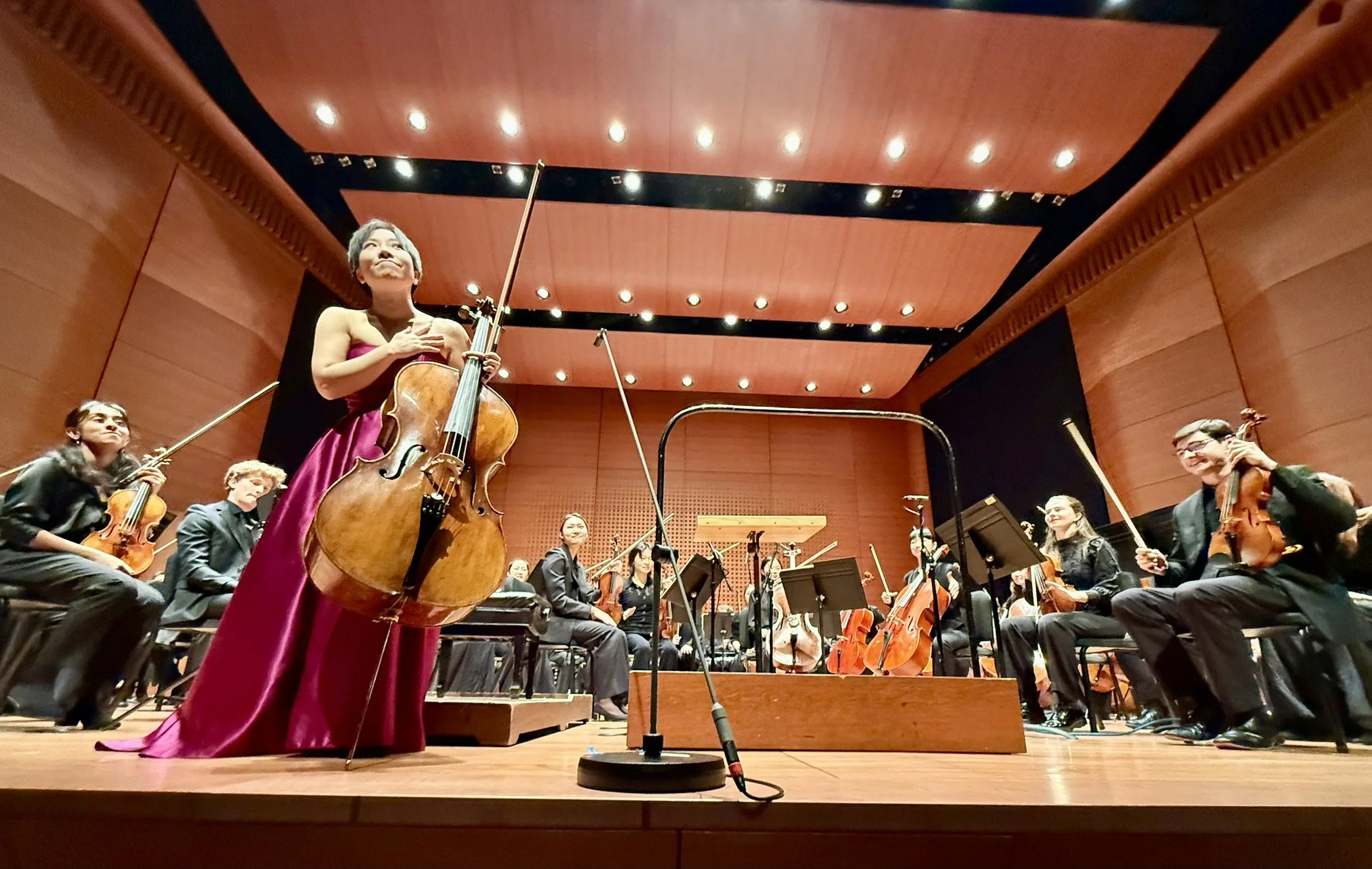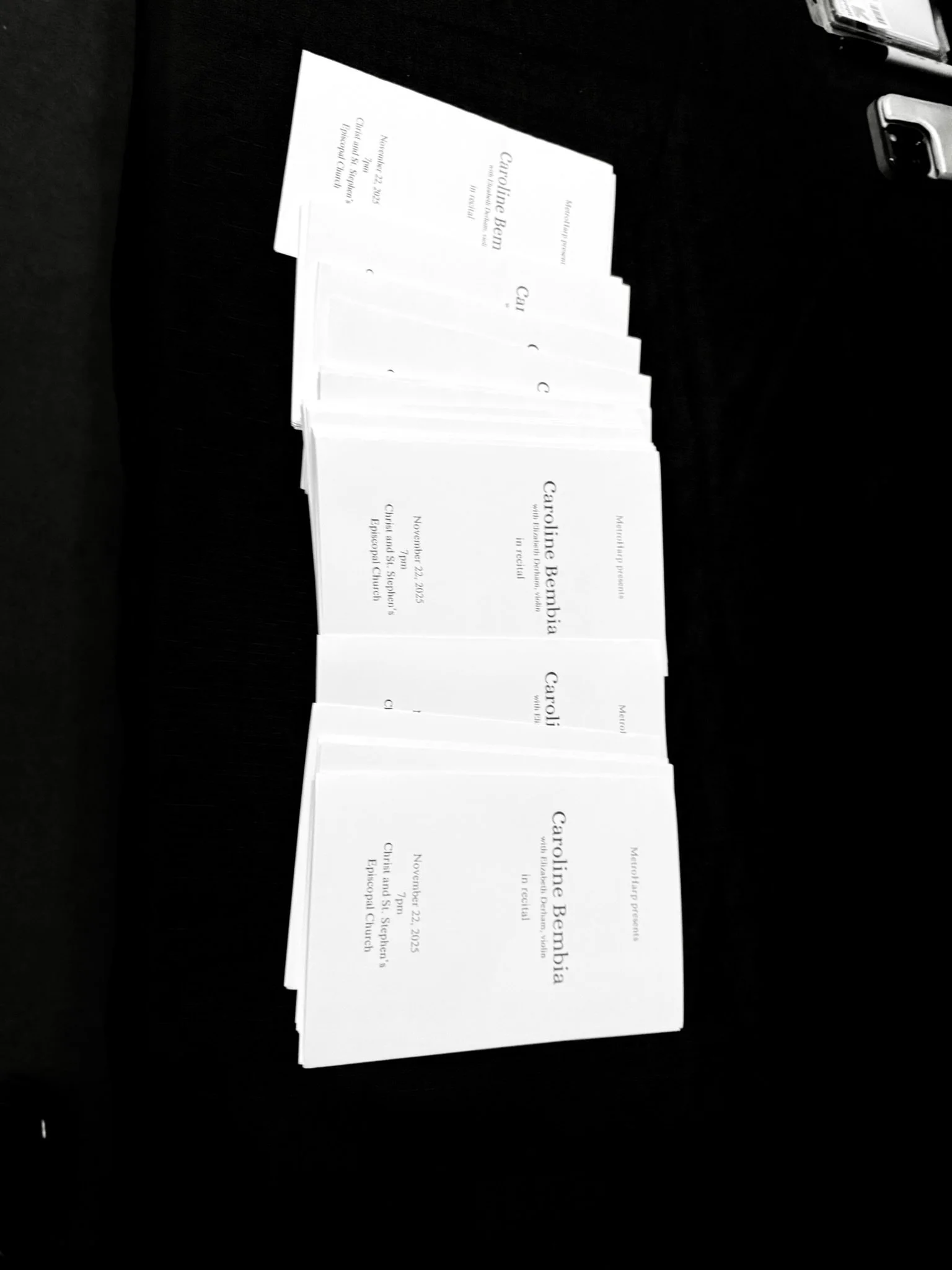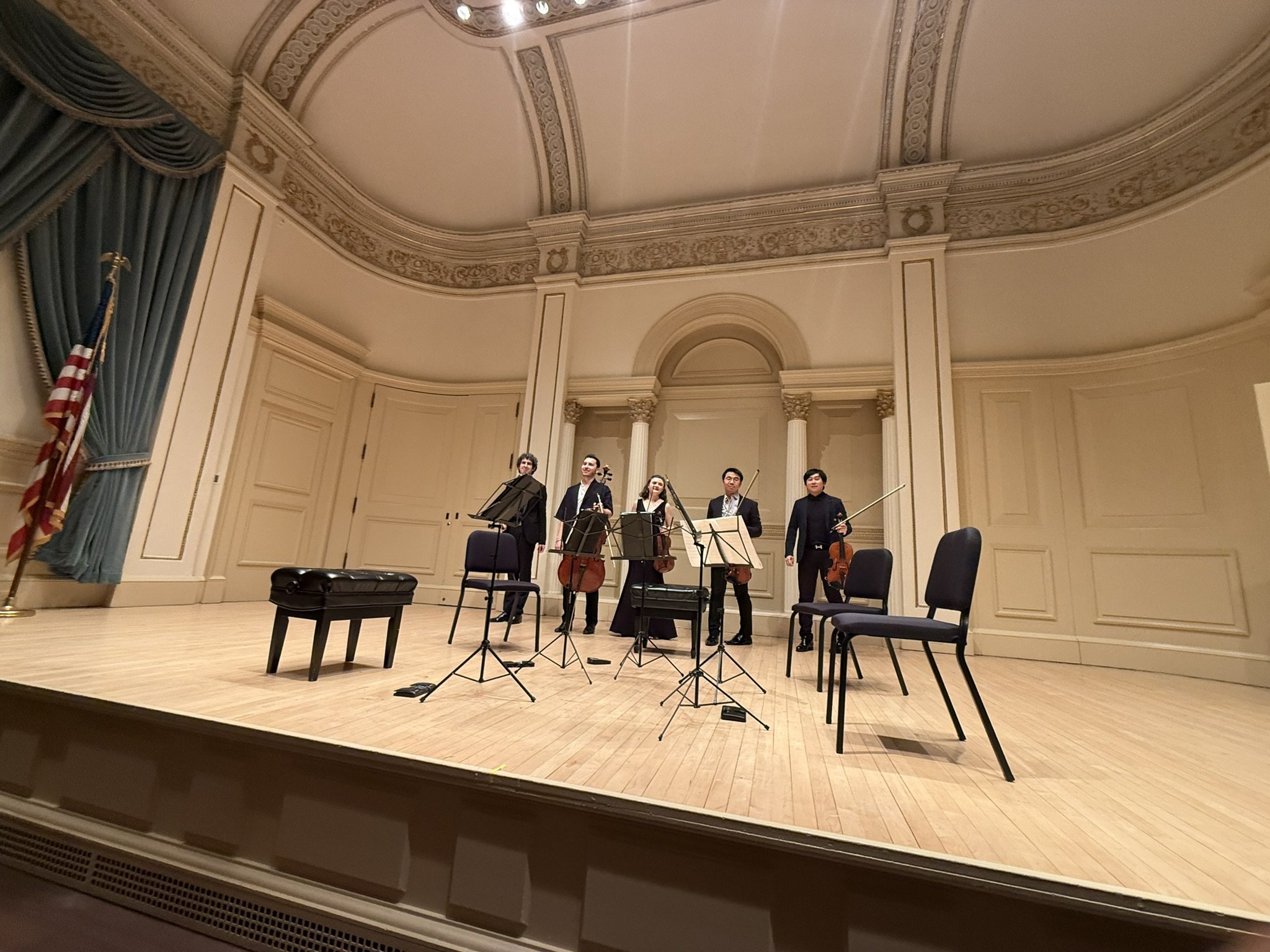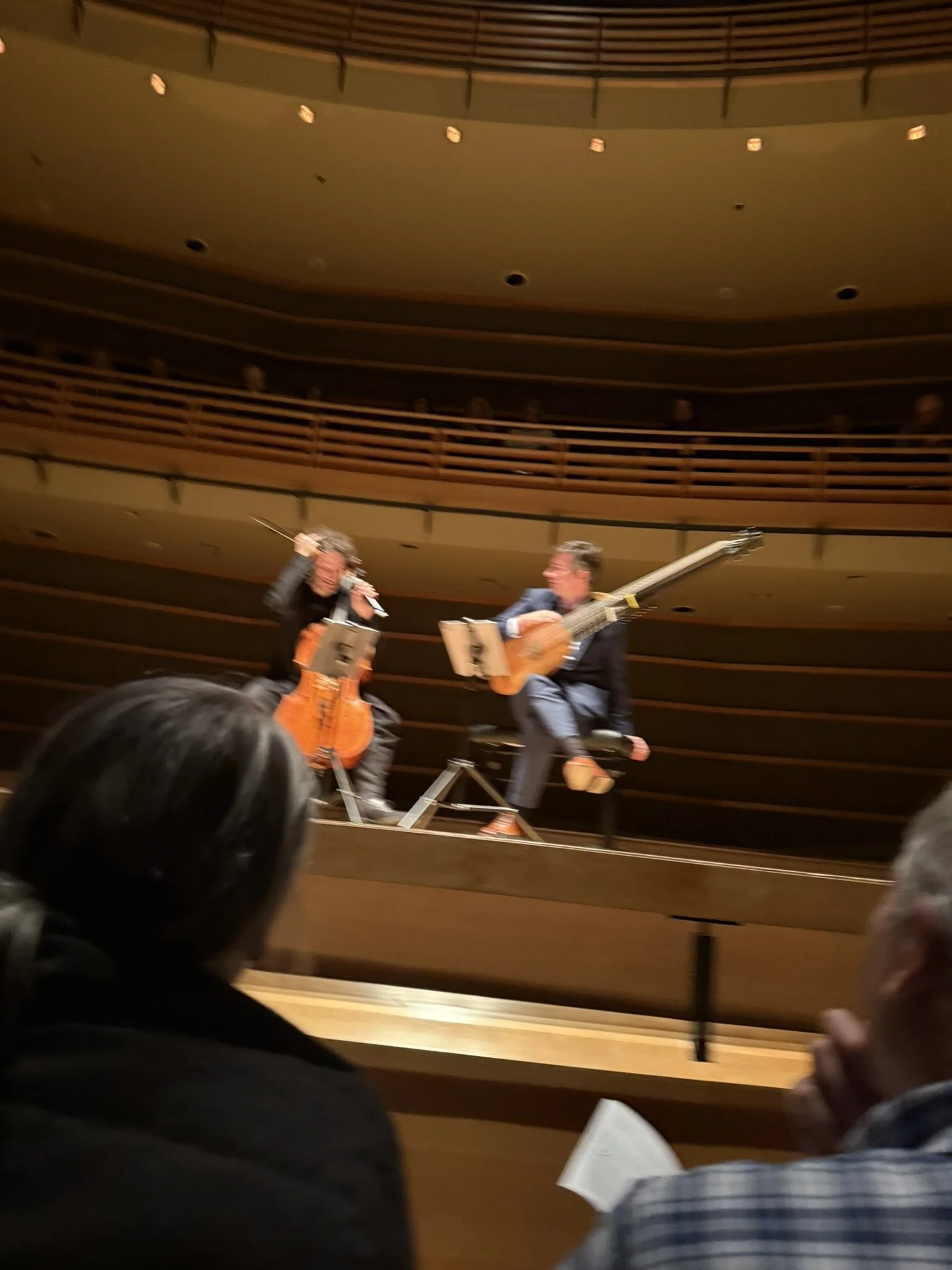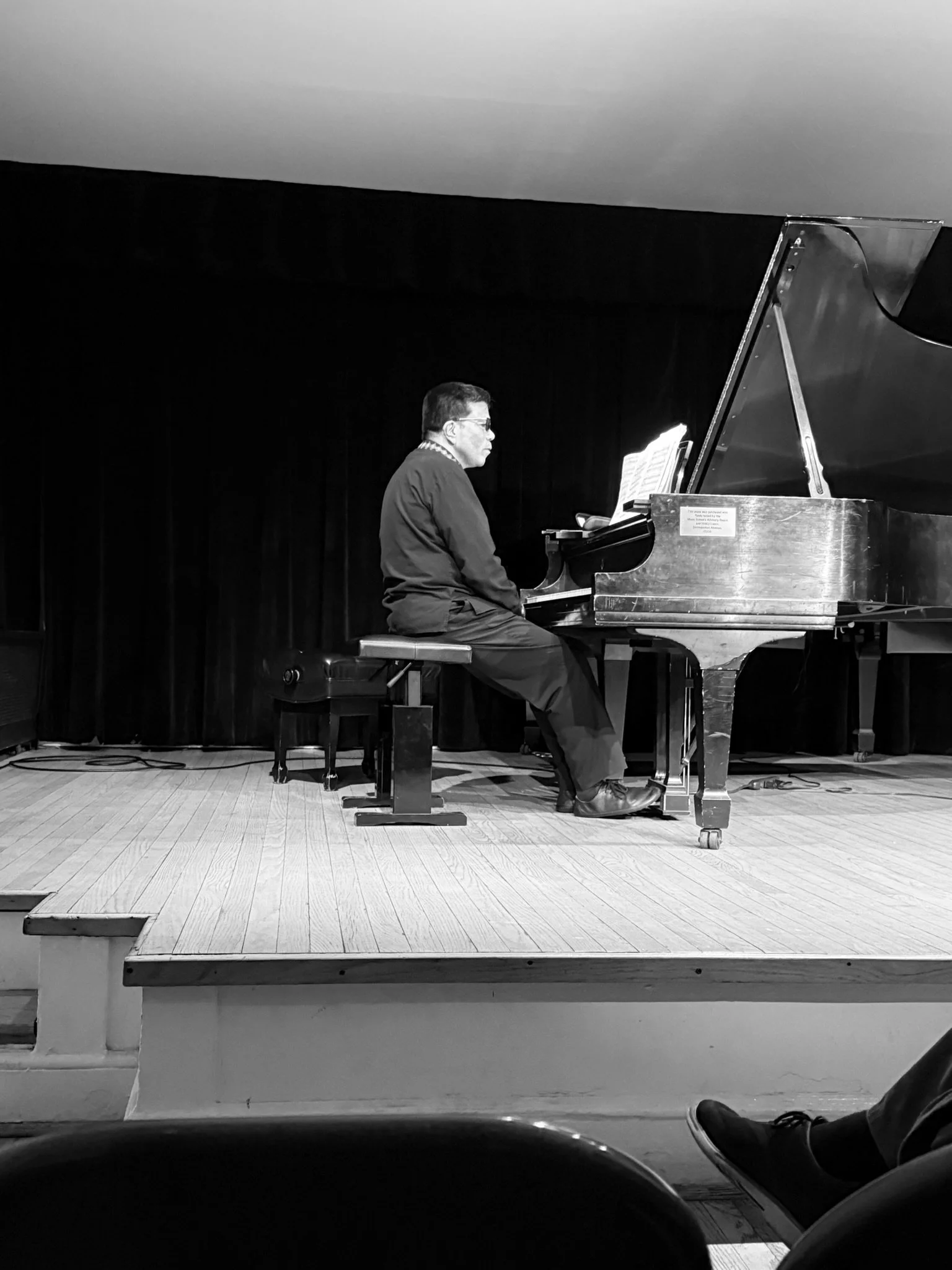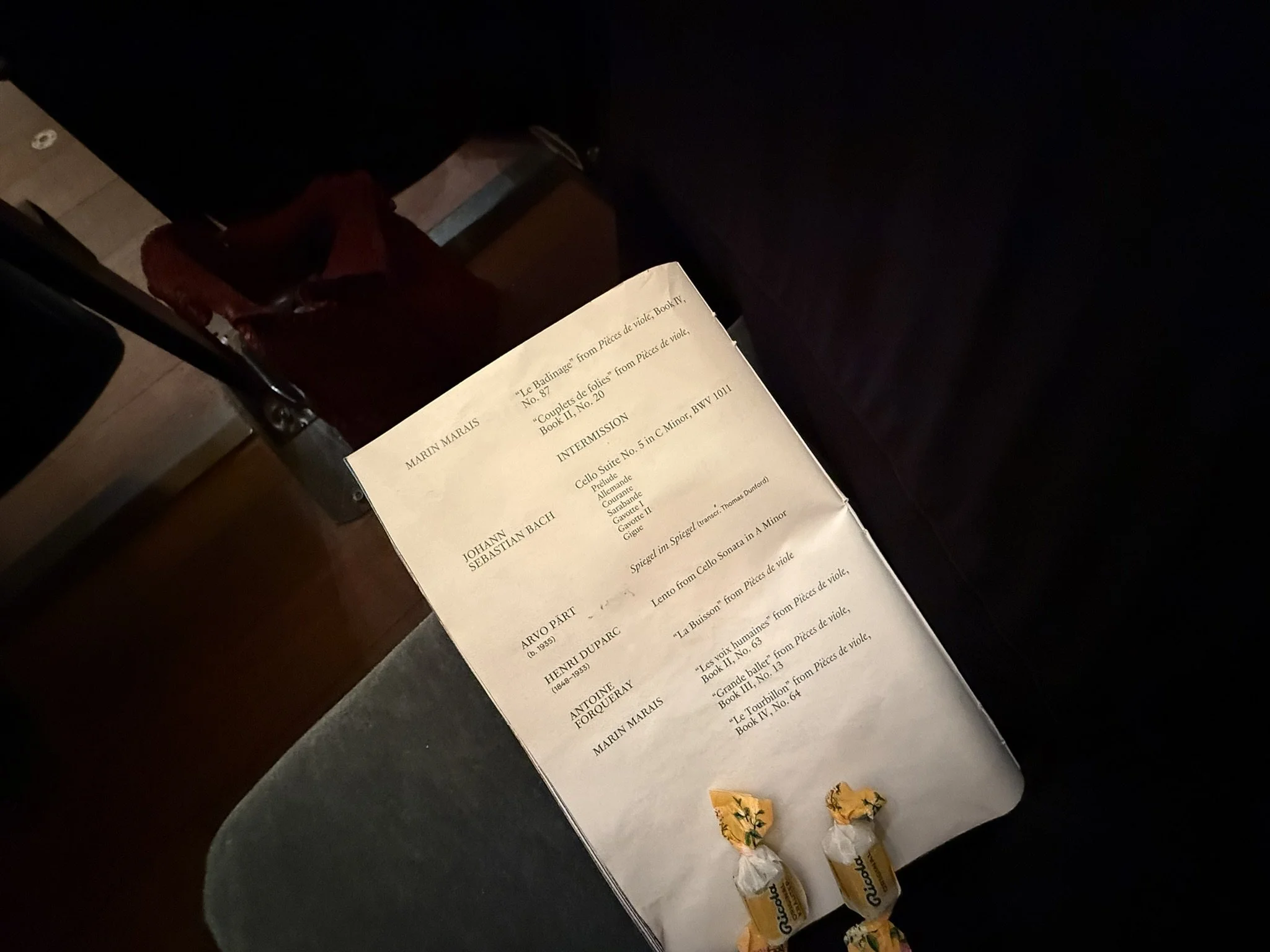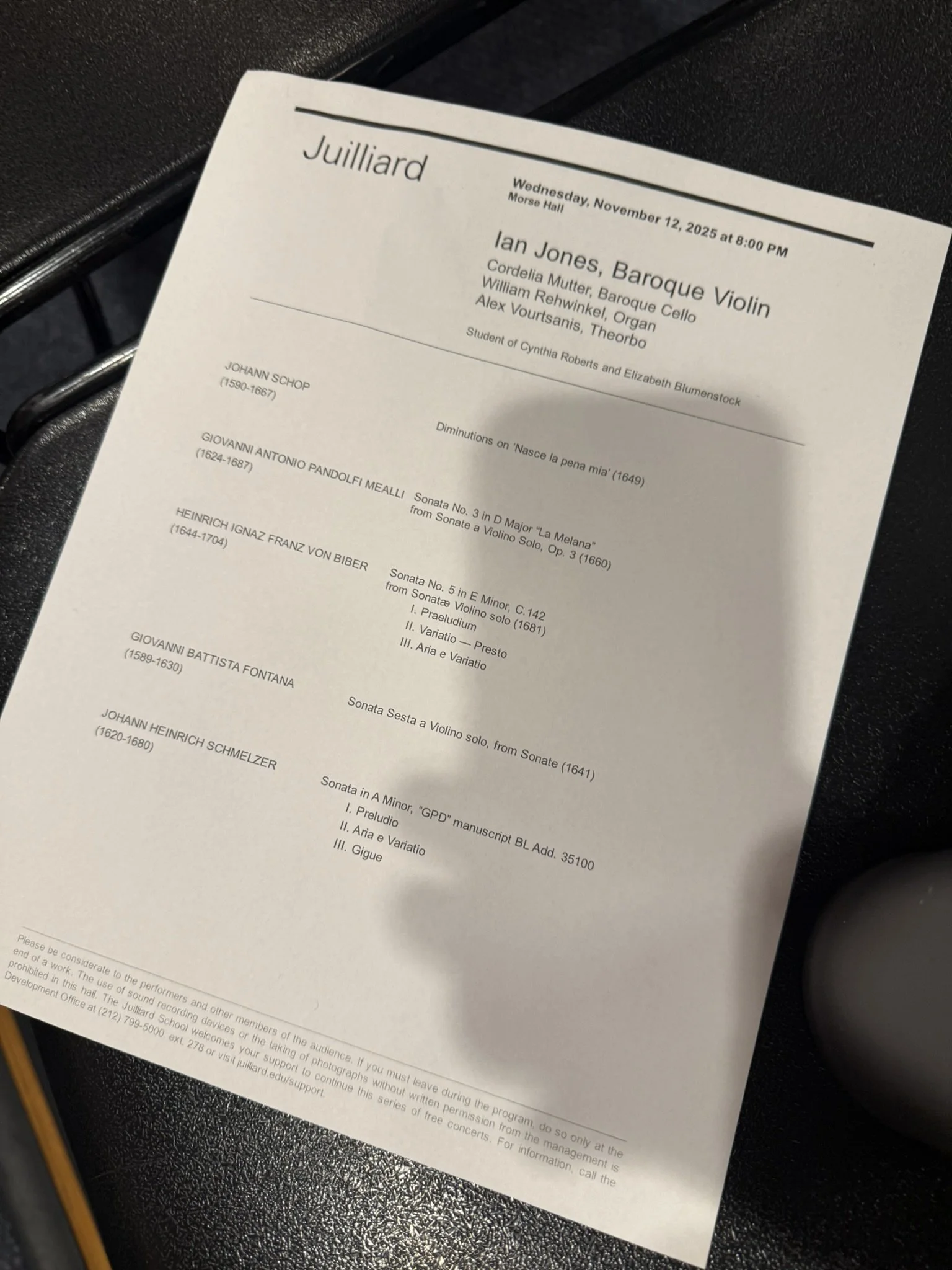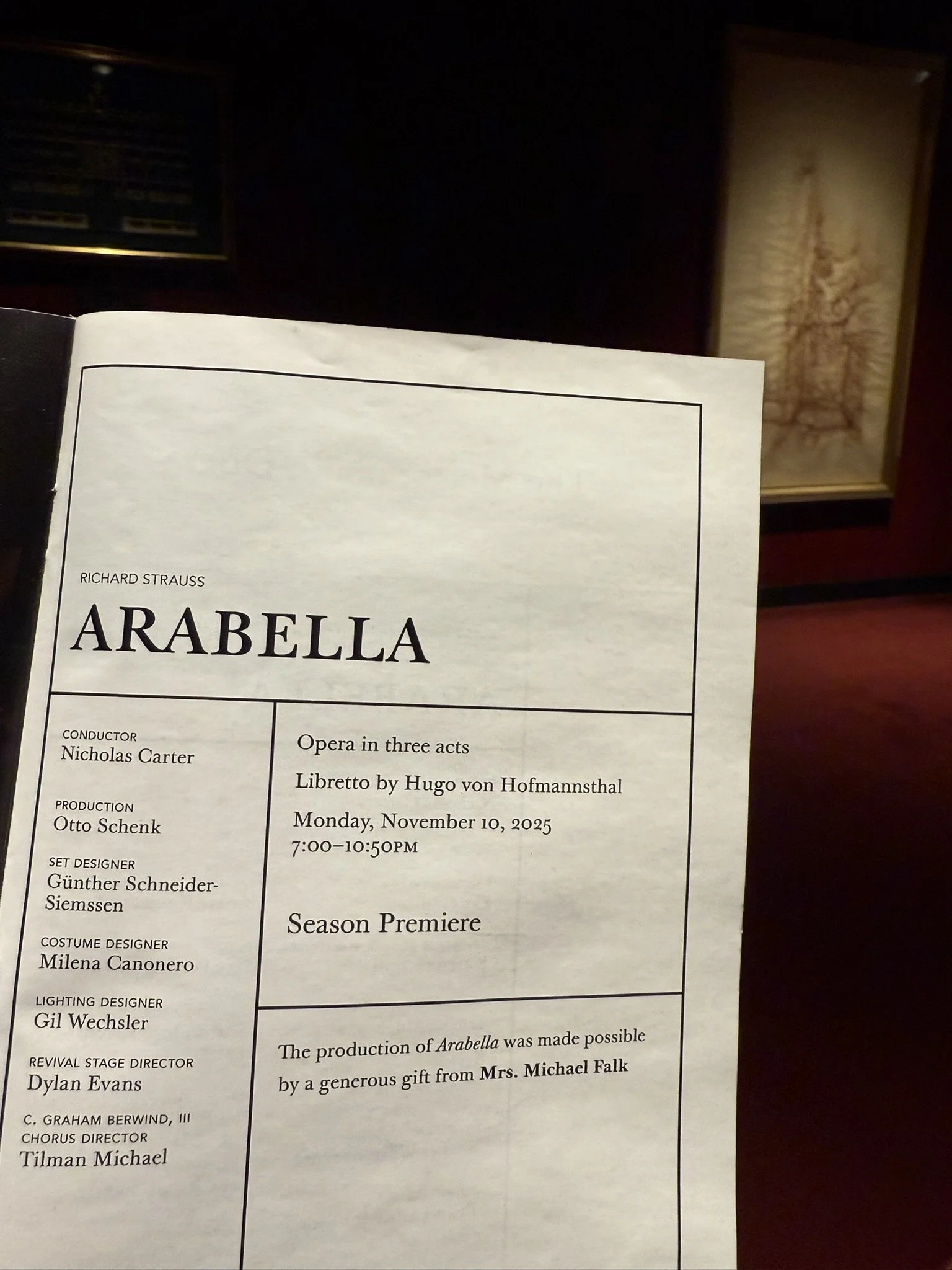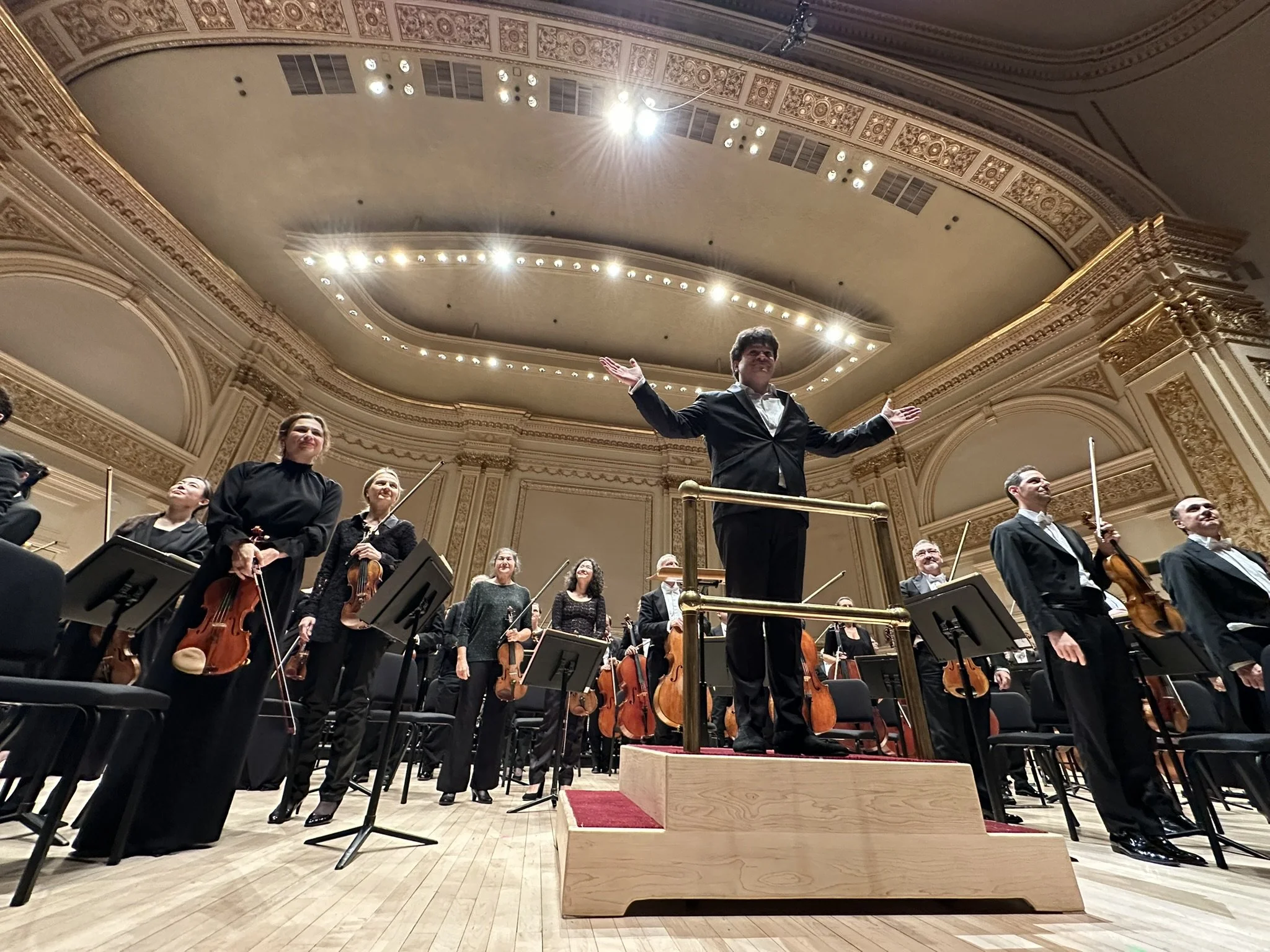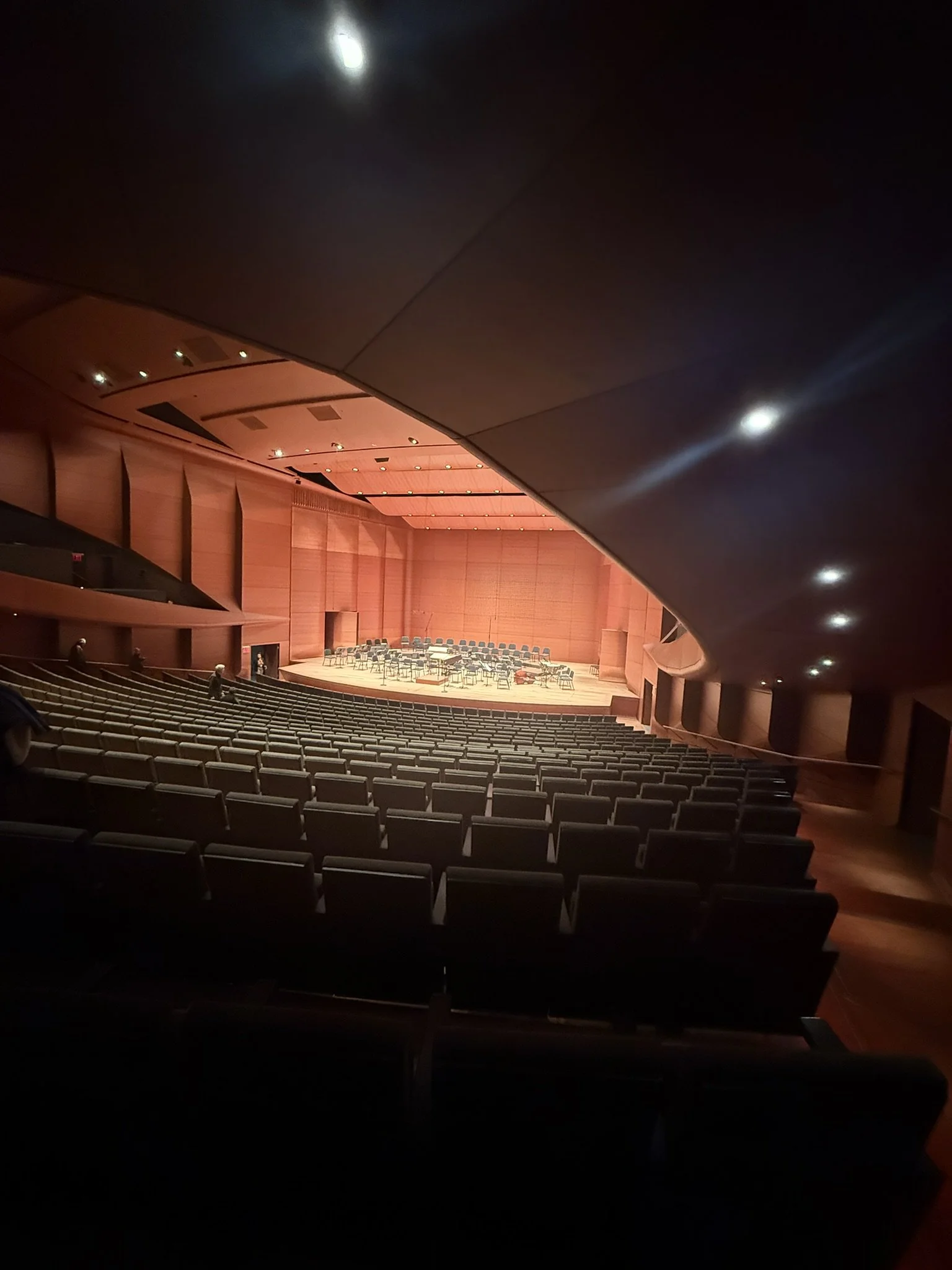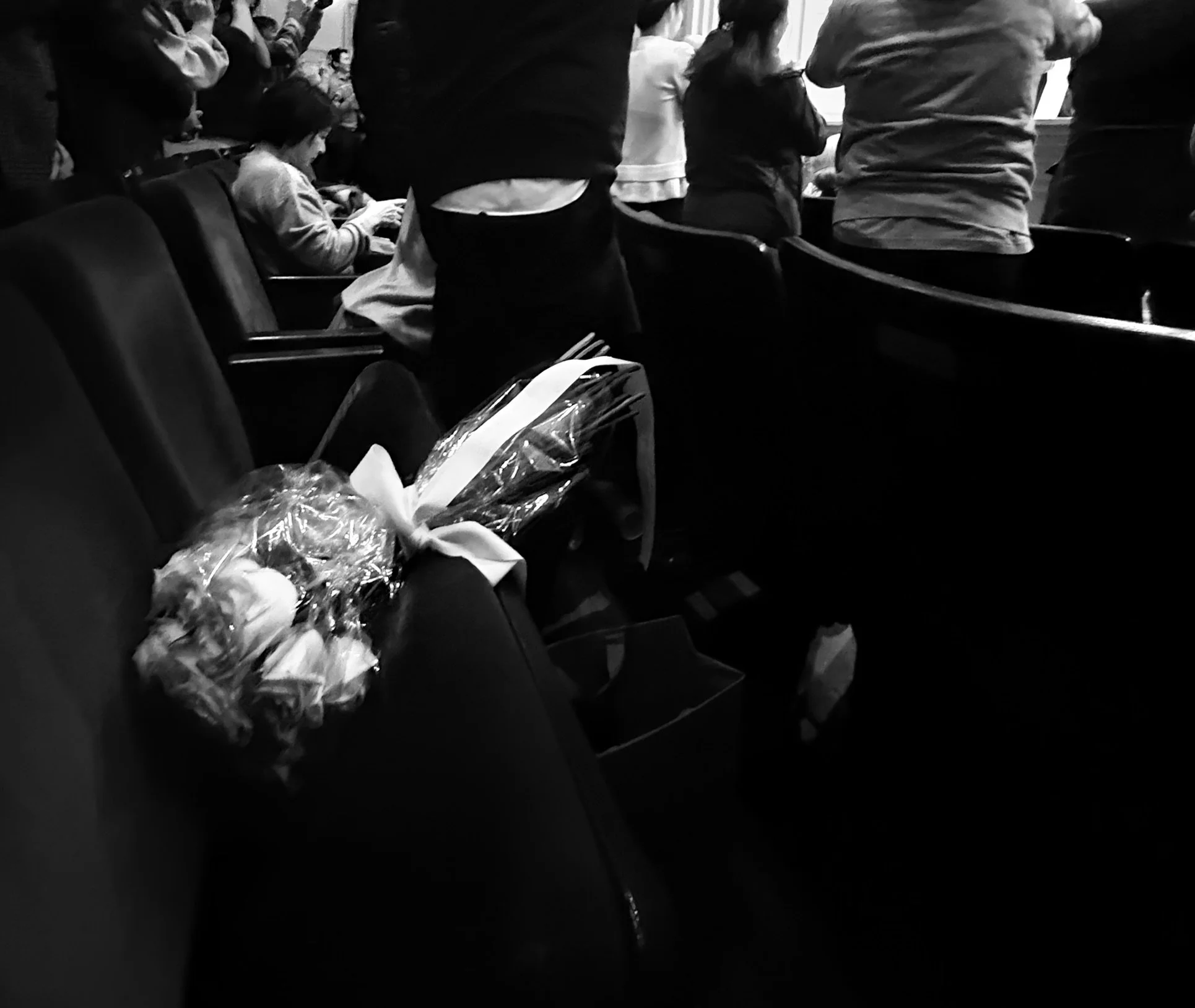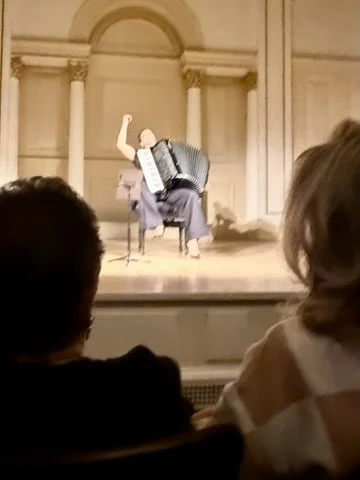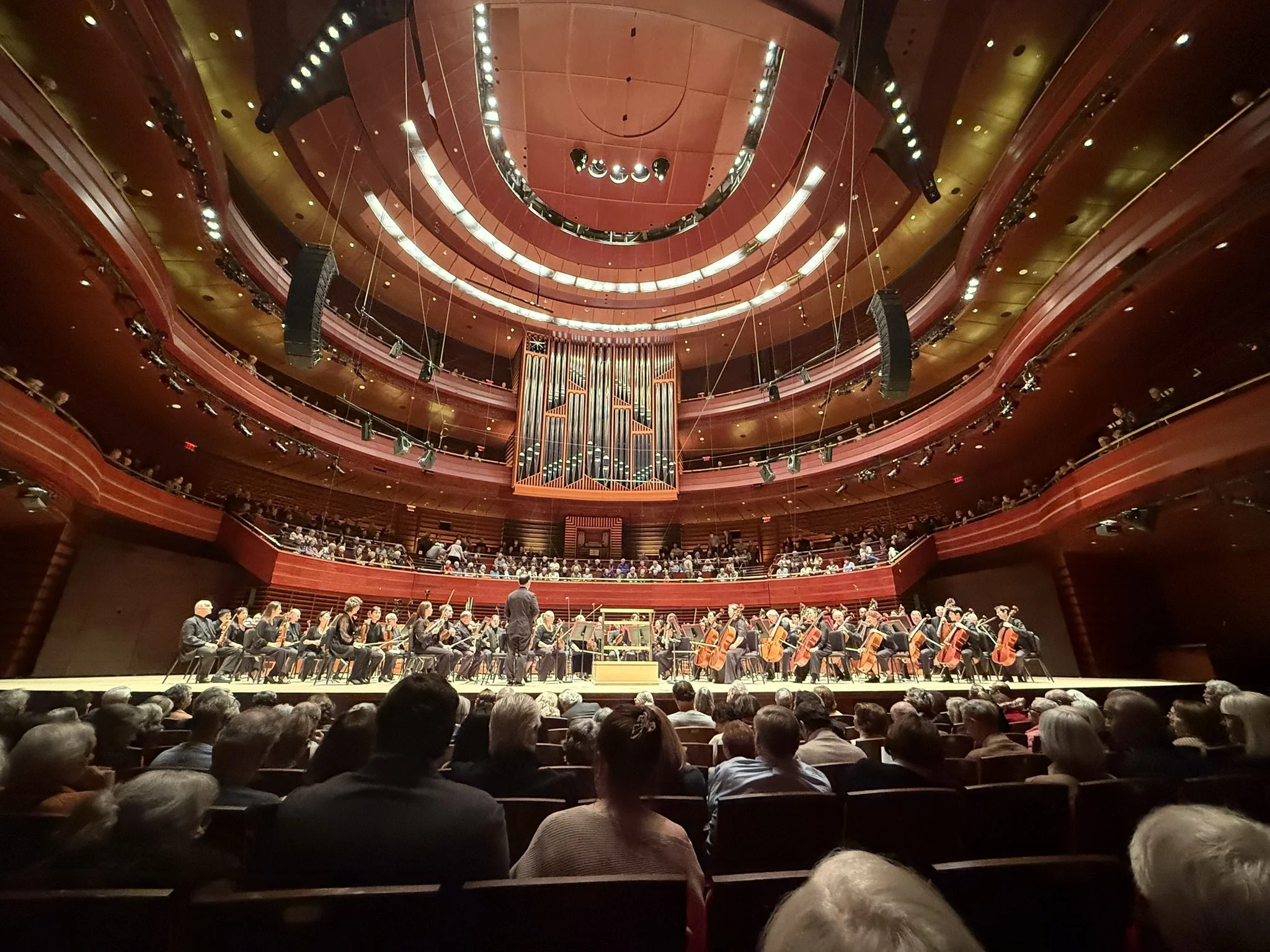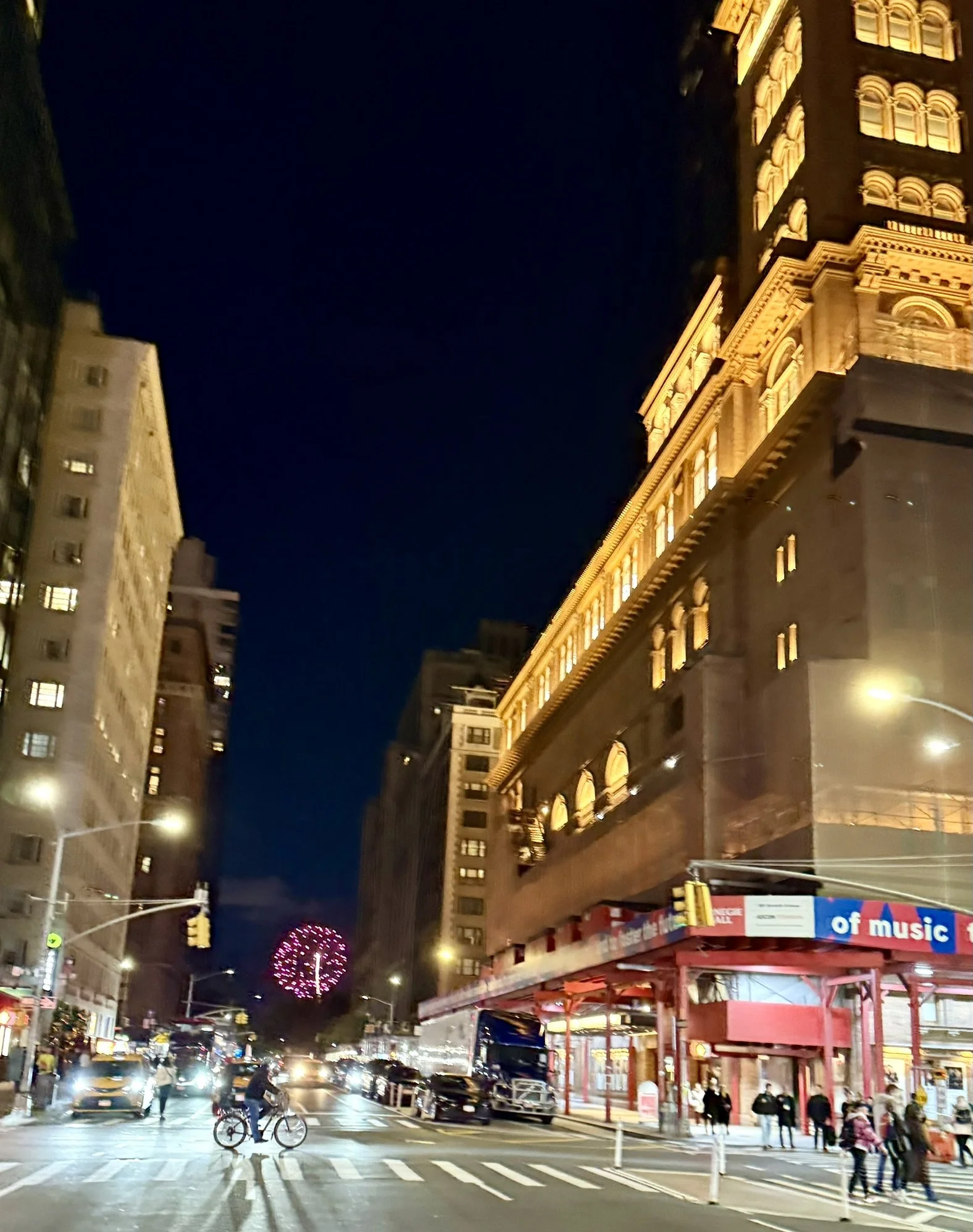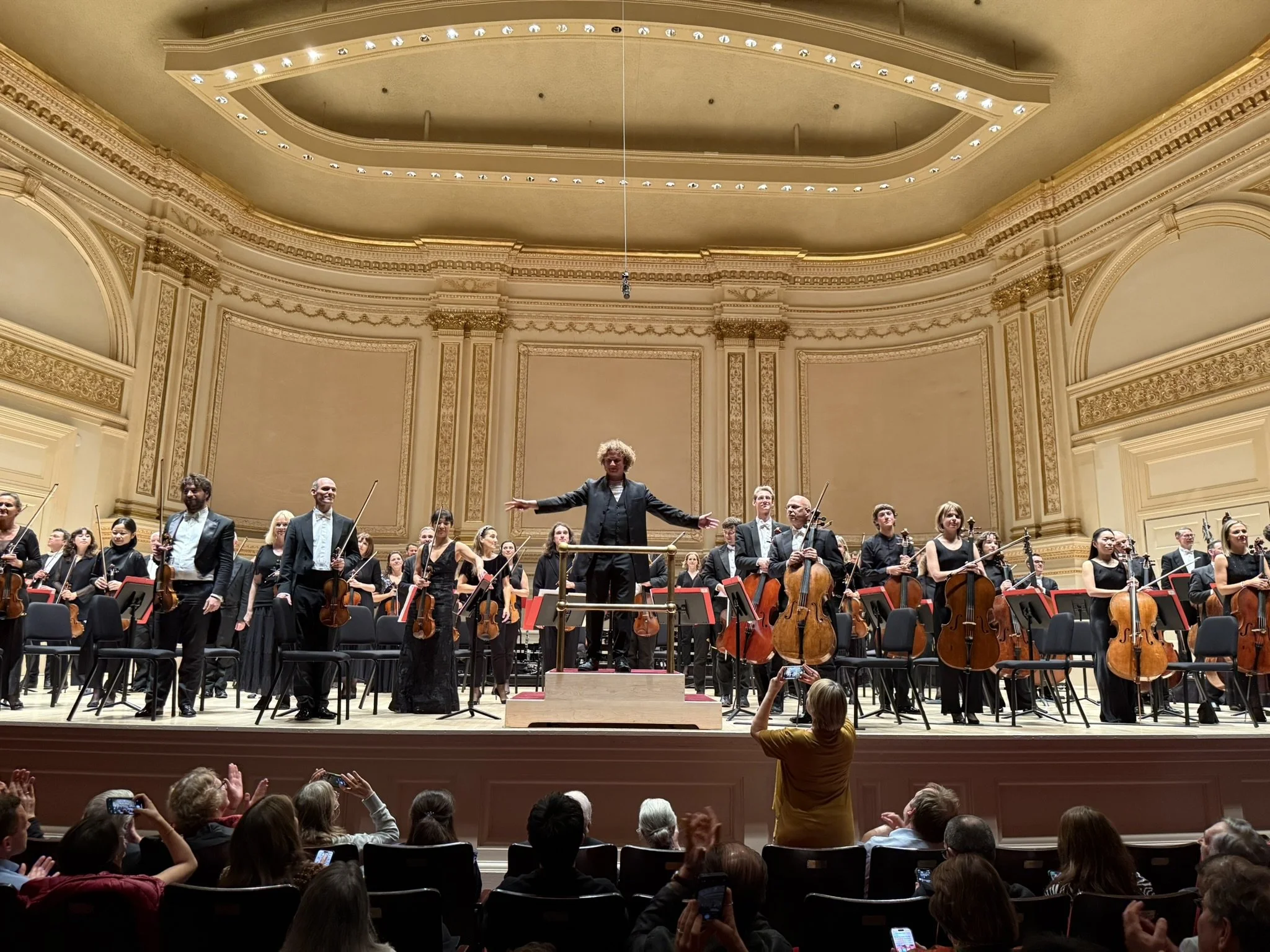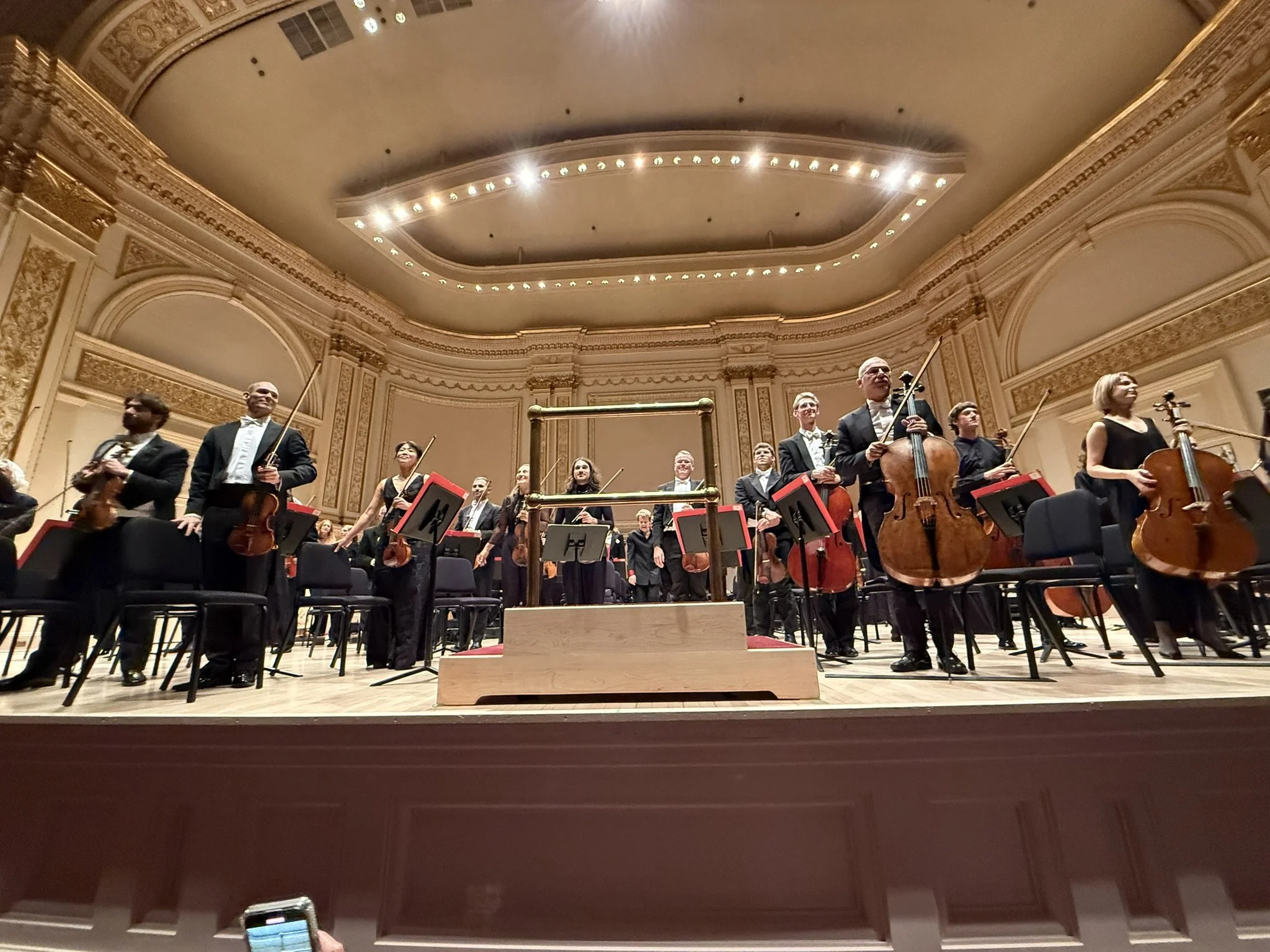When solo cellist Elena Ariza came to the stage, the orchestra and audience erupted in excitement. After a six-minute introduction, her solo begins, in variations four and five, where she mistakes a kidnapped lady and charges forward, slamming, and then the bass continues. Elena then immerses herself in her thoughts of an imaginary lover. Strauss was singing. It sounded like Waldner's singing in Arabella. She was completely Don Quixote, her bow strokes flawless, her lyrical and passionate singing conveyed directly.
Read MoreCaroline Bembia Harp Recital
Caroline Bembia, harp in a small church, 11.22.2025 —it was my first time attending a harp recital. Unlike the sharp attack of a piano or the vibration of percussion, her sound simply emerged and spread through the space. Unlike Lincoln Center’s cold precision or the Met’s rich resonance, the natural reverberation of the church walls let me fully appreciate the harp’s unique tone and dynamic range.
Read MoreThe Marlboro Soloists at Weill Recital Hall
11.21.2025 Musicians From Marlboro at Weill Recital Hall. A chamber music group made up of young musicians associated with the Marlboro Music Festival in the United States. The festival, established in 1951, is known as a place where young and experienced musicians come together to study and perform chamber music. Selected members of the group give concerts both in the U.S. and abroad.
Read MoreNicolas Altstaedt and Thomas Dunford at Perelman Theater in Philadelphia
On November 20, 2025, I went to Philadelphia to hear Thomas and Nicolas again. The 600-seat Perelman Theater was acoustically excellent. They began with Marais, and the audience let the lute and cello tones drift naturally. Thomas’s Bach felt bright and singing, while Nicolas’s Gigue in the second half moved me to tears, painting fading landscapes with his baroque bow. Surrounded by modern buildings, I imagined the roofs of an old church. Unlike Carnegie Hall, Philadelphia’s warmth, welcoming people, and audience engagement created a deep emotional experience, revealing scenery and intimacy that made this visit unforgettable.
Read MoreMexican pianist and musicologist César Reyes
César texted me about his recital, so I went. Since I knew him, this is my 1st time seeing his piano. He is a pianist who introduces South American music in the United States. The venue was a music school hall in West Manhattan, surrounded by friends and neighbors, and the concert started at 7:30 p.m.
Read MoreThe world of altstaedt and Dunford at Carnegie Hall
The world of Nicolas Altstaedt, Cello and Thomas Dunford, Lute's "viol x cello x lute x Bach x modern."that means all contemporaries, an intimate and stimulating dialogue between the two and the audience. The Bourbon sophistication and Bach. It continues with Pärt and then Marais.
Read MoreIan Jones, Baroque Violin at Juilliard
Ian Jones performed Baroque violin at Juilliard’s Morse Hall. Schop’s 1649 Diminutions use intricate variations; Pandolfi Mealli’s La Melana develops motifs with tempo shifts. Biber’s Sonata No. 5 contrasts silence and richness, while Fontana’s and Schmelzer’s works blend fantasia, cantabile, and technical mastery, showing early violin artistry across Europe.
Read MoreDr. Strauss's Arabella 1 at Met
Dr. Strauss's Arabella, which premiered in 1933, started its rebirth at the Met Opera on 11.10.2025. I love it the first time. The excitement and thrill of seeing the work I had been looking forward to for the first time are still fresh, even 11 years later. It's fun to see the completed Maestro vs. Met. It's also fun to see the highly anticipated new work. But the best part is being reunited with the best friends. It’s moving to see Maestro Nicholas Carter (Hamlet and Britten) with his whole body, sending life into Strauss’s music—urging the mighty Met Opera Orchestra, led by the concertmaster, Benjamin Bowman, to sing out and come alive.
Read MoreVéritable Trésor, Orchestre National de France
Christian Măcelaru and the Orchestre National de France at Carnegie Hall on 11.9.2025. The program began with Elsa Barraine’s Symphony No. 2, Voïna (War), composed in 1938, just before the outbreak of World War II. Barraine’s work captivates with its modern French transparency condensed into a stable structure.
Read MoreHendel's last Oratorio by Juilliard415
Handel’s oratorio Jephtha (1751) was performed by Juilliard415, Juilliard School’s period-instrument ensemble, on November 8, 2025, at Alice Tully Hall. This, his final oratorio, featured accompaniments to the arias that were varied and richly textured. The vocal ensemble consisted of five singers, ranging from soprano to bass, and the orchestra was full and vibrant. Even the basso continuo accompanying the recitatives was luxurious.
Read MoreKyung Wha, Chung-the rebirth and pride at Carnegie
At 77, Giant Violinist, Chung Kyung Wha once again stood at Carnegie Hall. This marked the culmination of her musical career. After a long career, a quiet flame and prayer resonated in the hearts of the enthusiastic audience gathered in the dry Stern Hall. There was no hesitation in the rise of each note, but the quiet determination and resolve that accompanied each note. It wasn't the fiery passion of her youth, but the power to burn like a quiet flame. The violin spoke of strength and kindness that transcend technique. Each time she drew her bow, the silence seemed to breathe, as if decades had passed. And after the sound faded, a prayer lingered. Kevin Kenner let each note speak as if it were a serene melody. Their breathing overlapped, creating a conversation through sound. Kenner added a soft glow to Chung's single note, and Chung responded to Kenner's silence with a prayerful echo—a dialogue that transcended.
Read MoreSymphonic Accordion, Ksenija Sidorova, Carnegie Debut
Ksenia Sidorova gave her debut recital at Carnegie Hall's Weill Recital Hall on 11.5.2025. Almost the entire program was arranged by Ksenia and friends, overflowing with respect for the works, musicians, and friends. As a result, the pieces were deeply connected, and Sidorova's world transcended time and style, unfolding through the accordion.
The program encompassed a wide range of genres, from American minimalism to Bach and numerous folk pieces, imitating a variety of instruments and voices, including organ, folk instruments, orchestra, and voice. The final piece was Schnittke's polystylism, the opera of satire and humor.
Read MorePhiladelphian accusitc at Anderson Hall
Yannick Nézet-Séguin, Music and Artistic Director
Emanuel Ax, Piano
Program
STILL Wood Notes
BEETHOVEN Piano Concerto No. 3
BRAHMS Symphony No. 3
Hoping to hear the sound of Ax again, I took the 9:00 a.m. train to Philadelphia on Sunday, November 1st. At 11:30, I asked at the box office if I could swap my seat from the upper to the orchestra, but no seats available. Anderson Hall, home of the Philadelphia Orchestra, was built before Sawallisch retired, and I attended a performance of Beethoven's Symphony No. 9 for their final concert. The glass exterior walls of the lobby let in plenty of fresh autumn sunlight. I had a delicious omelet nearby. The area around the venue was tranquil, and I enjoyed my time there. I listened to a beneficial lecture on Still's revisions. I was moved by reading the poems that influenced him. When I opened the program notes, each piece was accompanied by a helpful explanation. It was Halloween weekend. The venue was packed with veteran audience members. I asked at the box office again, and they swapped me for a seat in the middle of row 12, which became available. When the opening time arrived, I entered from the side of the stage. English hornist Elizabeth Starr Massoudonia was playing a Still passage. I watched Anderson's sound for the first time since April. She seemed to notice me and waved. I still remember her singing in the final act of Tristan and Isolde.
The wood resonated warmly. It was filled with air. The newly renovated David DeFen Hall in New York is also made of wood, but rather than the airy resonance of timber, the sound is already present in the space. While the design is incredibly meticulous, eliminating any sense of time lag, Anderson Hall in Philadelphia conveys the feel of the sound as it flows through the air. I asked an usher named Carol about Ax, and it seemed to be very familiar to Philadelphians. I asked a few other audience members, but their opinions varied. Watching them, unlike Carnegie or Lincoln, felt more like a group of children playing together in a neighborhood park. I was surprised when I saw the program and discovered they were playing Brahms's Symphony No. 3. I'd thought it was the same Symphony No. 4. When I sat down, a volunteer sat next to me. Apparently, a ticket had just become available and had been purchased. I don't know why she was in the middle, more than me. I bought several other tickets this time. Even though I looked the box officer in the eye and told her the seat number, she offered me a seat a few seats away from it. I don't understand that either. Philadelphia has a thorn inside. There's something precious and lost hidden in the sound of the Philadelphian. I was so intrigued by this, I really wanted to hear their Brahms this time. However, ever since I heard Yannick and the Philadelphia Orchestra's Verdi's Requiem at Carnegie Hall in 2012, he immediately followed up with Mahler's Symphony No. 9. I stopped going to Philadelphia. Still, now that I think back, I often realize that the Verdi I heard with my friend 13 years ago, in front of Maria Pavlovskaya in the second row, was Yannick's true art. It was insane. It was so powerful. It's still etched in my memory. Now, Yannick is one of the most important conductors in the American classical music industry, not only globally but also worldwide, alongside Nelsons in Boston and Dudamel in New York. He revived the Philadelphia Orchestra after it had filed for bankruptcy, and he maintains a packed schedule, working with American composers and young talent, as well as conducting operas and making guest appearances.
This year, especially as he turned 50, he will be conducting almost all of the Romantic period, from chamber versions of Mozart's Don Giovanni and Piano Concerto to Brahms' Symphonies, Wagner's Tristan und Isolde, and Bruckner's 3rd and 8th symphonies in the spring. He will be spending New Year's with Wiener. How will his 51st year in the classical music world loom?
Before the performance, Yannick congratulated Ax by announcement. It was like a guided ride at Disneyland. The audience's excitement was palpable. Yannick is a maestro of the world. Perhaps the Philadelphia audience, where the maestro guided the ride, was passionate European soccer fans. Even a star athlete can be criticized if they lose. The band members were slightly different from their New York gig for each song. Still began. It was like Fantasia. That dream world where Stokowski collaborated with Disney animation. It reminded me of the American Tom & Jerry, The Adventures of Tom Sawyer, and Anne of Green Gables, which I watched as a child. That impression was strong. It was more intimate than Carnegie, and Still's worldview unfolded. This Philadelphia Acoustic is deeply rooted in the American spirit. The most essential elements are the audience and the orchestra members. Time stood still with Beethoven. The audience around me was conveyed like a family dining at the following table. And then I saw the secret behind why Ax has remained so beloved. It was while listening to the second movement.
I saw his path, who knew how cruel the human heart can be. They were people who had seen the hearts of Mozart and Beethoven. At the time, they wrote music to make a living. And the reason music remains close to people's hearts more than 200 years later is because it inhabits people like Ax. Yannick is one of them. I couldn't remember the encore Ax played at Carnegie, so before the Brahms, I asked the cellist Jiayin He. He kindly asked the other musicians, so I told him to come back later. I thanked him for Beethoven and headed back to my seat, but the ladies in my row kept asking me if I was there. I wondered if their seat had their name on it, and they let me in. I'm a stranger.
Unlike Carnegie, Anderson Hall in Philadelphia seems to treat its acoustics as its own private sanctuary. All the principals except for concertmaster Kim are women. The principal double bass is Joseph Conyers. His balance was incredible. The music was delicate and precise, with its grain and fragrance, especially the pizzicato supporting the cello theme in the final movement, and the long notes supporting the fanfares and chorales. It was so good I kept smiling. The oboe and flute also had a rich, vibrant tone. At Carnegie Hall, the cello tutti was sung with masterful voices from the front, but this time, the back players were incredible—vivid, rich, and fresh in their lyricism. The left violin's voice was easily audible, but the cello and bass on the right were refined and tasteful. And then there were the violins and inner voices. The cello theme returned in the fourth movement, like a hammer hitting minerals buried in the earth. It wasn't in the front, but the back. Jiayin He and others were ringing. The soaring tremolo of the violin was also intense. I think the overall sound of the strings, before the glissando at the end of the first movement and the consordino in the fourth movement, is a signature of the Philadelphia sound. The sounds build up and then, for just a moment, they emit a powerful brilliance. It's the kind of divine whisper that Brahms must have seen. I just smiled, and for just a moment, Juliet Kang, who was next to Kim, seemed to turn and look at him. At that moment, perhaps the god Brahms had descended upon them as well.
Yannick instantly captured their hearts, painting them like a modern abstract artist with a fresco. He scooped up those delicate, chaotic feelings before they dried up and released them directly into us. Amid this lightness and speed, numerous stories were born: the poetry of Black America, the poetry and space of Beethoven, and Brahms's Third Symphony. From Still's beautiful, poetic portrayal of the origins of American-African classical music to Ax's Beethoven, which touches the soul, and contemporary Philadelphian Brahms, the performance connected and lingered in the mind as if it were a fleeting moment. After the piece finished, Yannick carefully introduced each soloist. I learned a lot from my seat in the middle, something I wouldn't have experienced had I been in the front. This time, I decided to go to Philadelphia on a whim, so I bought the tickets the day before. Since it was close, the travel and meal were very relaxing. At this performance, I experienced the secrets of the Philadelphia sound and its magnificent history. There's a lot you can only understand if you're there. I took the train home and was drinking beer in New York by 8 o'clock—cheers to Philly and Yannick.
アックスの音色をもう一度確かめたくて、11月1日の日曜日の午後、朝9時の電車でフィラデルフィアに向かった。11:30にボックスで上の階から下の席に交換してもらえるか尋ねたが、なかった。フィラデルフィア管弦楽団のホーム、アンダーソンホールはサヴァリッシュが引退する前に出来て、ベートーベンの9番が最後の公演で聴きに行った。ロビーにはガラス張りの外壁から秋の新鮮な太陽の光がたっぷり入り込む。近くでとてもうまいオムレツを食べた。べニューの周りはとても閑静でゆっくり時間を楽しんだ。スティルの校訂について、とても親切なレクチャーを聞いた。影響を受けた詩を読んで胸を打たれた。プログラムノートを開くと、どの曲もとても親切に説明が書いてあった。ハロウィーンの週末。ベテランのお客さんで溢れている。もう一度ボックスに尋ねると12列目の真ん中が空いたので交換してもらった。会場時間になり、ステージの横から入ると、イングリッシュホルンのエリザベス・スター・マソウドニアが、スティルのパッセージを奏でていたので、4月以来のアンダーソンの音色を眺めていたら、気が付いたのか手を振ってくれた。彼女のトリスタンの枯れた終幕の歌は今でも覚えている。木の暖かな響きがする。空気を沢山含んだ響きがする。改装されたニューヨークのデビットデフィンホールも木でできているが、空気を含んだ木の響きというよりは、音が空間に既に存在している。響きの時間差を感じさせない物凄く綿密な設計を感じるが、フィラデルフィアのアンダーソンホールは、音色の感触がそこに流れている空気に乗って伝わってくる。キャロルというアッシャーがいて、アックスについて尋ねてみたら、フィラデルフィアではとても馴染み深い様子が伝わってくる。他のお客さんにも数名尋ねてみたが、人によって違う。彼らの様子を見ていると、カーネギーやリンカンと違い、近所の公園で子供たちが入り混じって遊んでいるのと似ている。プログラムを開いて今回はブラームスの3番をやることを初めて知って焦った。ずっと同じ4番だと思っていた。席に着くと、横にボランティアをしている方が座った。直前に空いてチケットを取ったそうだ。なぜ、私よりも真ん中なのかよくわからない。今回は他にも数枚買った。席番号を目の前のチケット係に目を見て伝えているのに、その数席横の席を何度も進められた。それもよくわからない。フィラデルフィアには棘がある。フィラデルフィア管弦楽団の音色には失われてきた大切な何かが眠っている。私はそこがとても気になったので今回、彼らのブラームスを聴きたいと強く思った。しかし、2012年にヤニックとフィラデルフィアのベルディのレクエムをカーネギーホールで聴いて以来、そして、彼はすぐにマーラーの9番を演奏した。そして、私はフィラデルフィアに行くのをやめたが、今思い出すと、13年前、2列目のマリア・パブロフスカヤの前で、その友人と聴いたあのベルディがヤニックの真のアートだったんだと思うことがよくある。めちゃくちゃだった。とても強かった。今でも刻まれているからだ。そして今、ヤニックは世界ではもちろんだが、特にアメリカのクラシック産業では、ボストンのネルソンス、ニューヨークに来るデュダメルと並んで最も重要なデリジェントだ。破産申告をしたフィラデルフィア管弦楽団を再生し、アメリカの作曲家、若い才能の起用、オペラやほかのゲストとの掛け持ちと世界でも大変充実したスケジュールで活動している。特に50歳を迎えた今年は、モーツアルトのドンジョバンニやピアノ協奏曲の室内楽版から、ブラームスの交響曲、ワーグナーのトリスタンとイゾルデ、春にはブルックナーの3と8の指揮を執るため、ほぼロマン派を網羅する。さらに、新年はウィーンとニューイヤーを過ごす。彼の51年目の門出はこれからのクラシック界をどう占うのだろう。
演奏前にヤニックが放送でアックスを祝う言葉を述べた。まるでディズニーランドのガイド付きのアトラクションの様だ。聴衆たちのわくわくが伝わってくる。ヤニックは世界のマエストロだ。マエストロがアトラクションのガイド役を務めるフィラデルフィアの聴衆は、ヨーロッパの熱烈なサッカーファンなのか。スター選手でも負ければぼろくそに言われるのだろうか。メンバーは曲ごとにニューヨークと少し違っていた。スティルが始まった。まるでファンタジアの世界だった。ストコフスキーがディズニーアニメとコラボしたあの夢の世界。子供の頃見た、アメリカのトムとジェリーやトムソーヤの冒険、赤毛のアン。そういう印象が強い。カーネギーよりも親密でスティルの世界観が豊に広がる。このフィラデルフィアアコースティックはアメリカの精神に深く根ざしている。そして、その一番大事な要素はお客さんであり、オーケストラのメンバーだ。ベートーベンでは時間が止まった。周りのお客さんの意識も、隣のテーブルで食事する家族の様に伝わってくる。そして、アックスがなぜ人々に愛され続けてきたのか、その秘密が見えた。2楽章を聴いているときだった。アックスがたどってきた道を見た。人間の心がどれほど残酷か知っている人の調べだ。彼らはモーツアルトやベートーベンの心を見てしまった人たちだ。当時彼らはただ生きるために必死で曲を書いた。そして、200年以上たっても人々の心に寄り添い続けるのは、アックスの様な人間に音楽が魂を宿すからだ。ヤニックもその一人なのだ。休憩は15分だった。カーネギーでアックスが弾いたアンコールの曲が思い出せず、ブラームスが始まる前に、チェロのJiayin Heに声をかけた。彼は親切にも他の楽員にも尋ねようとしてくれたので、後でと、ベートーベンのお礼を言って席に戻ろうとすると、同じ列のはじのおばちゃんたちが、本当にお前の席かと何度も聴かれたので、あなたの席にあなたの名前は書いてあるのかと尋ねてみたら入れてくれた。私はよそ者なのだ。
アンダーソンホールのフィラデルフィアはカーネギーと違って、彼らはここのアコースティックを自分の庭にしているようだ。コンサートマスターのキム以外が全員女性のプリンシパル。コントラバス首席は黒人男性のJoseph Conyers。この方のバランスがやばかった。繊細にくっきりと、その粒や香り、特に終楽章のチェロのテーマを支えるピッチカートや、ファンファーレやコラールを支える和声の響き。もう笑いが止まらないくらいうまかった。オーボエとフルートも、響きも音色も物凄く充実している。チェロのトゥッティが、カーネギーでは前のプルトが卓越した歌を奏でてくれたが、この日は、後ろがすごかった。鮮やか、豊、そして新鮮。左は放っておいても耳に入るが、この洗練され味わい深い右のチェロとベース。そして、バイオリンと内声部。4楽章のチェロにテーマが戻ってきた時の鳴りが物凄かった。土の中に眠っていた鉱物にハンマーが合ったって響いた感じ。それは前ではなくて後ろだった。Jiayin Heたちが鳴っていた。バイオリンの駆け上がるトレモロも強烈だった。弦楽器全体の鳴りが、1楽章の終わりのグリッサンドや4楽章のコンソルディーノの前は、これがフィラデルフィアサウンドのシグネチャーだと思う。音がどんどん積まれて行って、一瞬だけ強烈な輝きを放つ。ブラームスが見たであろう神のささやき。私は笑っていた。
そしてほんの一瞬、キムの横にいたジュリエット・カンが、彼を振り向いたように見えた。あの瞬間、彼らにもブラームスの神が降りていたのかもしれない。
ヤニックは、彼らの心を瞬時に掴み、まるで現代抽象画をフレスコのように描く。感情が乾く前の、その繊細で混沌とした気持ちをすくい上げ、そのまま音楽の中に解き放つ。その軽さとスピードの中で、いくつもの物語が生まれていく。ブラック・アメリカンの詩情、ベートーヴェンの詩と余白、そしてブラームスの第3番。アメリカ=アフリカン・クラシックの原点を美しい詩情で描いたスティルから、人の心の奥に寄り添うアックスのベートーヴェン、そして現在のフィラデルフィアが奏でるブラームスを、一瞬の出来事の様に、繋げて人の心に残した。曲が終わると、彼はソリストをひとりひとりそれは丁寧に紹介してくれた。前では体験できないことを真ん中の席で沢山教わった。今回、突然フィラデルフィアに行こうと思って前日にチケットをとり、近いので移動中や食事はとてもリラックスできた。この公演では、フィラデルフィアサウンドの秘密をその壮大な歴史と体験した。実際、そこに行かないとわからないことだらけだ。帰りはすぐ電車で帰り、8時にはニューヨークでビールを飲んでいた。フィリーとヤニックのこれからに乾杯だ。
Ax and Philadelphia 50th at Carnegie Hall
At Carnegie Hall on October 31, 2025, The Philadelphia Orchestra with Emanuel Ax offered a luminous journey through Still, Beethoven, and Brahms—a concert where nature, spirit, and human expression intertwined. William Grant Still’s Wood Notes (1947), inspired by Shelby Steele’s nature poetry, shimmered with dialogue between instruments like rippling water, blending blues, jazz, and Romantic colors into warmth reminiscent of Dvořák and Sibelius. Beethoven’s Piano Concerto No. 3 followed—Ax’s 50th anniversary with the orchestra, and Yannick Nézet-Séguin’s birth year—bridging generations. Ax’s playing, breathing between each phrase, revealed Beethoven’s humanity with timeless tenderness, his cadenza rising to a Largo so intimate it brought tears. The finale’s laughter between violinist Kim and Yannick felt like Beethoven smiling from within. Ax’s encore, Schubert’s Serenade, was a whisper of love returned. After intermission, Brahms’s Symphony No. 4 unfolded as a spiritual heir to Bach’s Cantata No. 150, its sound rising and vanishing like mist. Yannick’s refined bass lines and luminous phrasing wove Still’s nature and Beethoven’s soul into Brahms’s deep serenity—a seamless celebration of Ax, Philadelphia, and the living continuum of music itself.
Read MoreSanttu-Matias Rouvali, Nordic Beethoven, Carnegie Hall Debut
The Philharmonia’s 80th anniversary concert on 10.29.2025 opened with Gabriela Ortiz’s If Oxygen Were Green, a vivid 21st-century exploration of light, water, carbon dioxide, consonance, and dissonance. Beethoven’s Piano Concerto No. 5 followed, with Víkingur Ólafsson’s playful, defiant piano weaving through the orchestra, while principal cellist Tim Hugh and the basses created tender, whispering tones that blended woodwinds and strings in intimate dialogue. Under Santtu-Matias Rouvali, the orchestra breathed with distinct shapes, colors, and intentions, alternating freedom and discipline like a modern Beethoven. Sibelius’s Symphony No. 5 unfolded with microtonal patterns, off-beat syncopations, and evolving themes; bass and cello provided a living pulse, while horns, winds, and strings conversed with microscopic detail, merging human emotion and natural sublimity. The Andante mosso recalled Beethoven’s Ninth, the third movement rose like a creature shedding its skin, and the finale’s deep cello-flute resonance and bass drum strokes created a timeless, awe-filled silence. Over two days, the warmth of cello and double bass, especially in the Sibelius waltz encore, revealed the orchestra’s capacity to transform controlled technique into simple, joyful, Karajan-like radiance.
Read MorePhilharmonia's Libestod at Carnegie Hall
The Philharmonia Orchestra celebrated its 80th anniversary with a three-week US tour, culminating in its final performance at Carnegie Hall. It was a performance that captured the breath and heart trembling of their past. The lustre of the strings, the warm breath of the woodwinds, and the brilliance of the brass—the gentle light of old recordings—represented the love, death, and salvation of Romeo and Juliet. The loneliness beneath Prokofiev's brightness, particularly the momentary silence in the second movement, seemed to stand still. And then, Kantorow's Wagner/Liszt rendition of Tristan's Death of Love from Isolde, which released this loneliness, projected the light and shadow of the Philharmonia Orchestra's lifelong love and death, forever etched in the hearts of the audience.
Read MoreTõnu Kaljuste, Conductor. My 1st time in New York, a musician called back to an empty stage after the entire program.
Pärt's pain in silence at dry Zankel
Für Lennart in memoriam (2006) honors Lennart Meri, evoking light and sea; L’abbé Agathon (2004) portrays monk Agathon’s kind deeds; Stabat Mater (1985/2008) contrasts anguish and prayer through voices and strings; Magnificat (1989) modernizes polyphony with tintinnabuli; Te Deum (1985–2007) embodies sacred stillness by Estonian.
Read MoreSilence is the Power, Arvo Pärt's 90th at Carnegie Hall
At Carnegie Hall on October 23, 2025, Paavo Järvi led the Estonian Festival Orchestra and Choir in a luminous celebration of Arvo Pärt’s 90th birthday—a journey through sound, silence, and faith. From the solemn bell of Cantus in Memory of Benjamin Britten to the turbulent energy of Perpetuum Mobile and the haunting redemption of La Sindone, each work revealed Pärt’s struggle for spiritual truth amid oppression. The choir’s unified cry in Adam’s Lament evoked humanity’s exile and hope, while Tabula Rasa, with Midori and Hans Christian Aavik, blazed with life before dissolving into sacred stillness. An encore of Passacaglia glowed with Brahms-like warmth, followed by the serene timelessness of Fratres and the cathartic faith of Credo. The evening ended in the gentle peace of Estonian Lullaby, affirming Pärt’s profound humanity—his art born not of profession, but of silence and soul.
Read MoreThe Principals of the Israel Philharmonic Orchestra at Carnegie Hall on 10.18.2025
Israeli talks by Haim and Tchikovsky at Carnegie Hall
The third day of the Israel Philharmonic's Carnegie Hall performance. Shani is truly fascinating. First of all, his conducting looks Barenbom. He plays the final, dragging note of Tchaikovsky's 6th Symphony. The double bass is muted and plays the final note. The double bass stops. The orchestra's consciousness continues even after the sound has died down. The score specifies the length of the piece, and it ends with a fermata. He doesn't lower his baton. When Jeff, sitting next to me, applauds first, this memory becomes eternal. Shani is a conductor who unleashes everything in the concert. In one section, Shani did not time the Munich Philharmonic's principal cello, Thomas Ruge, and principal violin, Dumitru Pocitari, to enter simultaneously. Since they both enter at their own pace, the individuality of the cello and violin sections, each carrying the main melody, is highlighted. Shani's conducting brings out the artistry of each performer and unlocks unknown possibilities. Even when they are not synchronized, their individual voices eventually become a dialogue, overflowing with a single, powerful energy.
Read MoreLa Fille du Régiment, the Colors spread like a live fresco on an autumn night in New York.
Donizetti’s La Fille du Régiment, which premiered in 1840, opened at the Met Opera on 10.17.2025. Refined and flexible overture. The strings flowed in a legato unlike Mozart or Bellini—light, supple, smooth as silk. Under Sagripanti’s brushwork, the Met Orchestra’s colors spread like a live fresco on an autumn night in New York.
Read More
